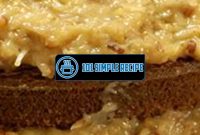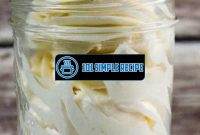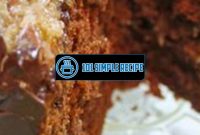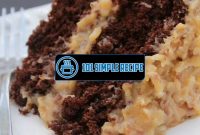If you’ve ever wanted to dive into the world of Swiss meringue buttercream but hesitated due to the lack of a stand mixer, fear no more! Making this luscious frosting without a stand mixer is not only possible but also surprisingly easy. Whether you’re a beginner baker or a seasoned meringue maestro, this article will guide you through the step-by-step process of creating silky, smooth Swiss meringue buttercream without the need for a bulky appliance. With just a few simple tools and a bit of elbow grease, you’ll be slathering your cakes and cupcakes with this delightfully fluffy frosting in no time. So put on your apron, grab a whisk, and let’s get whisking!
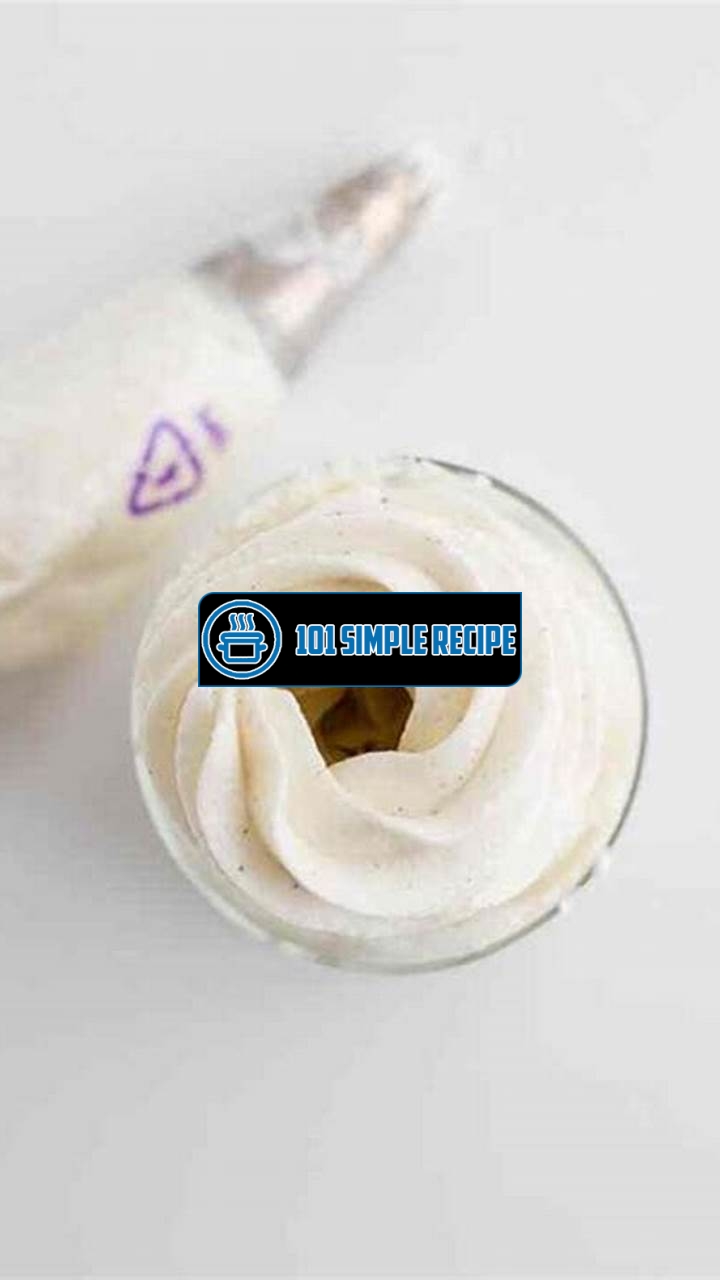
Understanding the Basics of Swiss Meringue Buttercream
Swiss meringue buttercream is a versatile frosting that is commonly used for cakes and desserts. It offers a smooth and creamy texture, making it the perfect addition to any sweet treat. In this section, we will delve into the key components and characteristics that make Swiss meringue buttercream so delightful.
The Foundation: Egg Whites and Sugar
Swiss meringue buttercream starts with a simple yet powerful combination of egg whites and sugar. The egg whites provide the necessary protein structure while the sugar adds sweetness and stability. Together, they create the foundation of this delectable frosting.
The egg whites: The first step is to separate the egg whites from the yolks. It’s important to ensure that no traces of yolk are mixed in with the whites, as even a small amount can prevent the egg whites from reaching their full volume. For best results, use fresh eggs at room temperature.
The sugar: Adding sugar to the egg whites not only provides sweetness but also stabilizes the meringue. It helps to create a glossy and stable mixture that can hold its shape. When combined with the egg whites, the sugar creates a thick and shiny meringue base for the buttercream.
A Light and Fluffy Texture
One of the standout characteristics of Swiss meringue buttercream is its light and fluffy texture. This is achieved through a unique cooking process of the egg whites and sugar. Unlike other buttercreams, Swiss meringue buttercream is cooked over a double boiler, which helps ensure that the sugar fully dissolves into the egg whites.
Pro tip: Ensure that the water in the double boiler is simmering gently, not boiling vigorously, as excessive heat can cook the egg whites too quickly and result in a grainy texture.
Once the sugar has dissolved and the mixture reaches a safe temperature, it is transferred to a mixing bowl and beaten until cool. This step is crucial, as it allows the meringue to cool down and achieve a stable structure. Cooling the meringue also ensures that it won’t melt the butter when it’s added later on.
Flavor Variations and Additions
Swiss meringue buttercream is incredibly versatile when it comes to flavor variations and additions. You can use a variety of extracts, such as vanilla, almond, or citrus, to add a delicious twist to your buttercream. Additionally, you can incorporate other ingredients like cocoa powder, melted chocolate, or fruit purees to create unique flavors.
Cocoa powder: Adding cocoa powder to Swiss meringue buttercream creates a rich and chocolaty flavor. You can adjust the amount of cocoa powder to suit your taste preferences, from a subtle hint to a pronounced chocolate taste.
Fruit purees: Incorporating fruit purees, such as raspberry or strawberry, adds a burst of fruity goodness to your buttercream. Make sure to strain the puree beforehand to remove any seeds or pulp, resulting in a smooth and velvety finish.
Keep in mind that when adding these additional ingredients, you may need to adjust the consistency of the buttercream. This can be done by adding more powdered sugar if it becomes too runny or a small amount of milk or cream if it becomes too stiff.
Tip: Experiment with different flavors and combinations to find your signature Swiss meringue buttercream flavor!
With the foundation of egg whites and sugar, a light and fluffy texture, and endless flavor variations, Swiss meringue buttercream is a fantastic choice for any dessert creation. Whether you’re making a birthday cake or decorating cupcakes, this versatile frosting will surely impress!
Looking for another delicious recipe that doesn’t require a stand mixer? Try this cookie in a mug recipe for a quick and easy treat.
The Science Behind Swiss Meringue Buttercream
Swiss meringue buttercream is a deliciously light and fluffy frosting that is loved by many. But have you ever wondered about the science behind its creation? Understanding the scientific principles behind Swiss meringue buttercream can help you achieve the perfect texture and stability every time you make it.
When making Swiss meringue buttercream, it’s important to consider how different factors can affect its stability and texture. One of the key factors is whipping the egg whites to perfection. This step is crucial in creating the light and airy consistency that Swiss meringue buttercream is known for.
Whipping Egg Whites to Perfection
Whipping egg whites to perfection is all about creating a stable foam. The protein in the egg whites forms a matrix that traps air bubbles, giving the meringue its light and fluffy texture. To achieve this, start by using room temperature egg whites as they whip up better than cold egg whites. Adding cream of tartar or a pinch of salt can also help stabilize the egg whites and improve their volume.
As you beat the egg whites, they will go through various stages. At first, the egg whites will be frothy, then they will become foamy, and eventually they will turn glossy with soft peaks. It’s essential to stop beating the egg whites at this point to prevent overmixing, which could lead to a collapsed meringue.
Whipping egg whites to perfection is the foundation of a successful Swiss meringue buttercream. Be sure to use room temperature egg whites and stop beating once soft peaks form to achieve the perfect texture.
The Role of Sugar in Structure Formation
Sugar plays a crucial role in the structure formation of Swiss meringue buttercream. When sugar is added to the whipped egg whites, it helps stabilize the meringue further by interfering with the proteins, creating a stronger foam. It also adds sweetness and enhances the overall flavor of the buttercream.
To ensure the sugar is fully dissolved and incorporated into the meringue, it’s important to add it gradually while continuing to beat the mixture. This allows the sugar to dissolve completely and prevents graininess in the final buttercream.
Sugar not only adds sweetness but also helps stabilize the structure of Swiss meringue buttercream. Remember to add it gradually and beat well to ensure a smooth and delicious frosting.
The Importance of Temperature Control
Temperature control is another critical factor when making Swiss meringue buttercream. Heating the mixture to the right temperature ensures that the sugar is fully dissolved and the egg whites are cooked to a safe temperature. It also helps create a stable emulsion when the butter is added.
When heating the egg whites and sugar, it’s essential to use a double boiler to gently heat the mixture. This prevents the eggs from cooking too quickly and becoming scrambled. The mixture should be warmed until the sugar is completely dissolved and the temperature reaches around 160°F (71°C).
️ Maintaining the right temperature throughout the process is vital for achieving a smooth and stable Swiss meringue buttercream. Use a double boiler and monitor the temperature carefully to create a perfect frosting.
In conclusion, understanding the science behind Swiss meringue buttercream can help you create a frosting with the perfect stability and texture. By whipping the egg whites to perfection, adding sugar gradually, and controlling the temperature, you can achieve a deliciously light and fluffy buttercream that will elevate your desserts to a whole new level.
If you don’t have a stand mixer, don’t worry! You can still make Swiss meringue buttercream. Check out this garlic bread stick recipe that requires no stand mixer.
The Traditional Stand Mixer Method
Swiss meringue buttercream is a delicious frosting that adds a light and velvety texture to your cakes and pastries. While the traditional method of making this buttercream involves using a stand mixer, it is possible to achieve the same results without one. By understanding the conventional technique of making Swiss meringue buttercream using a stand mixer, you can explore alternative methods and still achieve a mouthwatering final product.
Step-by-Step Instructions for Stand Mixer Method
To make Swiss meringue buttercream using a stand mixer, follow these step-by-step instructions:
- Egg White Preparation: Start by combining egg whites and sugar in a heatproof bowl. Place the bowl over a pot of simmering water, ensuring that the bottom of the bowl does not touch the water. Whisk the mixture constantly until the sugar dissolves and the mixture reaches a temperature of 160°F (71°C).
- Meringue Formation: Transfer the heated egg white mixture to the stand mixer bowl. Attach the whisk attachment to the stand mixer. Begin beating the mixture on low speed, gradually increasing the speed to medium-high. Continue beating until stiff peaks form and the mixture has cooled down to room temperature.
- Butter Incorporation: Switch from the whisk attachment to the paddle attachment on your stand mixer. With the mixer running on medium-low speed, gradually add small cubes of softened butter. Allow each cube to fully incorporate into the meringue before adding the next one. Once all the butter has been added, increase the mixer speed to medium-high and beat until the buttercream is smooth and creamy.
- Flavor and Texture Enhancements: Lastly, add in your desired flavorings, such as vanilla extract or other extracts. Beat the buttercream for an additional few minutes to ensure a well-blended and smooth texture.
Benefits and Drawbacks of Using a Stand Mixer
Using a stand mixer for making Swiss meringue buttercream offers several benefits. Firstly, it significantly reduces the effort and time required to achieve the desired texture. The powerful motor and attachments of a stand mixer efficiently whip the egg whites and incorporate the butter, resulting in a light and airy buttercream. Additionally, the stand mixer allows for hands-free operation, freeing you up to focus on other aspects of your baking process.
However, there are also drawbacks to using a stand mixer. Firstly, it can be a pricey investment, particularly for home bakers who may not use it frequently. Stand mixers also occupy significant countertop space, which can be a concern in smaller kitchens. Furthermore, the loud noise generated by stand mixers may disrupt the peaceful ambiance of your kitchen.
Troubleshooting Tips for Stand Mixer Method
While the stand mixer method provides consistent results, it is important to note some potential issues and their solutions:
- Runny Buttercream: If your buttercream turns out runny, it may be due to the butter being too soft or the meringue not being fully cooled. Try refrigerating the mixture for a short period and then beating it again until it reaches the desired consistency.
- Curdled Buttercream: Curdling can occur if the buttercream is too cold or the meringue is too warm. Let the mixture come to room temperature and then beat it again to bring it back to a smooth consistency.
- Grainy Texture: Graininess can result from adding butter that is too cold or adding it too quickly. Ensure that the butter is at the ideal temperature and add it gradually, allowing each cube to fully incorporate before adding more.
Experimenting and adapting traditional recipes to suit your tools and preferences is part of the joy of baking. Don’t be afraid to try making Swiss meringue buttercream without a stand mixer – you may discover a new favorite method that works perfectly for you!
Alternatives to a Stand Mixer: Hand Mixer and Whisk
If you don’t have a stand mixer but still want to indulge in the heavenly delight of Swiss meringue buttercream, fear not! There are alternative methods that can be used to achieve the same delicious results. Two popular options are using a hand mixer or a trusty whisk. Let’s explore how each method can be used to create the perfect Swiss meringue buttercream.
Using a Hand Mixer: Step-by-Step Guide
The hand mixer is a convenient and efficient tool that can save you time and effort when making Swiss meringue buttercream. Here’s a step-by-step guide on how to make it using a hand mixer:
- Prepare your ingredients and ensure they are at room temperature. This includes egg whites, granulated sugar, unsalted butter, and flavorings such as vanilla extract or cocoa powder.
- In a heatproof bowl, combine the egg whites and sugar. Place the bowl over a saucepan with simmering water. Make sure the bottom of the bowl does not touch the water.
- Whisk the egg whites and sugar constantly until the sugar has dissolved and the mixture reaches a temperature of around 160°F (71°C). You can check this using a candy thermometer.
- Remove the bowl from the heat and transfer the mixture to a larger bowl. Begin whisking the mixture using a hand mixer on medium-high speed. Continue whisking until the mixture cools down to room temperature and forms stiff peaks.
- Once the meringue has cooled, gradually add in small pieces of softened butter while still whisking. Continue whisking until all the butter has been incorporated and the mixture is smooth and creamy.
- Add your desired flavorings and mix until well combined. Swiss meringue buttercream can be flavored with vanilla extract, chocolate, fruit purees, or any other flavoring of your choice.
- Your Swiss meringue buttercream is now ready to be used! Spread it on cakes, cupcakes, or use it as a delicious filling.
Whisking by Hand: A Labor of Love
If you are up for a bit of an arm workout and want to channel your inner pastry chef, whisking by hand is another option for making Swiss meringue buttercream without a stand mixer. Here are the steps to follow:
- Begin by whisking the egg whites and granulated sugar in a heatproof bowl placed over simmering water. Keep whisking until the sugar has dissolved and the mixture has reached a temperature of around 160°F (71°C).
- Once the sugar has dissolved, remove the bowl from the heat and transfer the mixture to a larger bowl. Prepare yourself for some serious whisking!
- Using a wire whisk, briskly whisk the mixture in a circular motion for about 10-15 minutes, or until the meringue cools down to room temperature and forms stiff peaks.
- Once the meringue has reached the desired consistency, gradually add small pieces of softened butter while continuing to whisk vigorously. This step requires patience and perseverance.
- As you add the butter, you will notice the mixture becoming smooth and creamy. Keep whisking until all the butter has been incorporated.
- Add your favorite flavorings and give the mixture a final whisk to ensure everything is well combined.
- Voila! Your homemade Swiss meringue buttercream is now ready to be enjoyed.
Pros and Cons of Hand Mixer and Whisk Methods
Both the hand mixer and whisk methods have their own advantages and disadvantages when it comes to making Swiss meringue buttercream. Let’s take a closer look:
Hand Mixer:
- Pros: The hand mixer is a convenient tool that saves time and effort. It ensures consistent results and is easier on the arms compared to whisking by hand.
- Cons: It requires the use of electricity and an additional appliance to store.
Whisk:
- Pros: Whisking by hand gives you a sense of accomplishment and allows you to truly connect with the process. It requires minimal equipment and is a great option if you don’t have a hand mixer.
- Cons: It is time-consuming and requires more effort than using a hand mixer. It may also be challenging for those with physical limitations.
Ultimately, the choice between a hand mixer and a whisk depends on your personal preferences, available resources, and the amount of time and effort you are willing to invest. Whatever method you choose, the end result will always be a delectable Swiss meringue buttercream that will elevate your desserts to new heights!
Mastering the Technique: Tips and Tricks
When it comes to making Swiss Meringue Buttercream without a stand mixer, there are a few valuable tips and tricks that can help you achieve successful results. These tips can be applied regardless of the method you choose to use. So let’s dive in and master this technique!
Temperature Management: Key to Success
One of the most important aspects of making Swiss Meringue Buttercream without a stand mixer is proper temperature management. ️ It’s crucial to ensure that all your ingredients are at the right temperature to achieve the perfect texture and consistency.
Firstly, make sure your eggs and butter are at room temperature. This allows them to incorporate smoothly and evenly into the meringue. You can speed up the process by placing the eggs in a bowl of warm water for a few minutes and cutting the butter into small cubes.
Secondly, pay close attention to the temperature of your meringue. It should reach 160°F (71°C) to ensure that the egg whites are cooked properly. Use a candy thermometer to check the temperature and avoid overcooking or undercooking.
By managing the temperature effectively, you’ll be able to create a silky and stable Swiss Meringue Buttercream without the need for a stand mixer.
Choosing the Right Utensils and Equipment
While a stand mixer might not be available, choosing the right utensils and equipment can greatly impact the outcome of your Swiss Meringue Buttercream.
If you don’t have a stand mixer, an electric hand mixer or a whisk can be great alternatives. They allow you to whip the meringue until stiff peaks form and incorporate the butter smoothly. Just be prepared for a bit of an arm workout!
Additionally, using a stainless steel or glass mixing bowl can make a difference. These materials retain heat better than plastic, which helps stabilize the meringue. Avoid using plastic bowls as they tend to trap oil, which can affect the final result.
Remember, the utensils and equipment you choose can influence the success of your Swiss Meringue Buttercream, so choose wisely!
Pacing and Patience: Avoid Overmixing
When making Swiss Meringue Buttercream without a stand mixer, pacing and patience are key. It’s essential to avoid overmixing the meringue, as it can result in a dense and heavy buttercream.
After adding the butter to the meringue, mix it just until it is fully incorporated. Overmixing can cause the butter to separate and create a greasy texture. It’s better to undermix and have a few small lumps than to overmix and ruin the consistency of your buttercream.
Take breaks during the mixing process to allow the butter and meringue to come together properly. This will also help prevent overheating and maintain the desired texture.
Practice pacing and be patient throughout the process. The result will be a smooth and creamy Swiss Meringue Buttercream that you can be proud of! ⏳
Note: With these tips and tricks, you can confidently make Swiss Meringue Buttercream without a stand mixer. Remember to manage the temperature effectively, choose the right utensils and equipment, and avoid overmixing. Happy baking!
If you’re in the mood for homemade bread, this kaiser roll recipe is perfect. No stand mixer needed!
Frequently Asked Questions
Here are some frequently asked questions about making Swiss meringue buttercream without a stand mixer:
| No. | Questions | Answers |
|---|---|---|
| 1. | Can I make Swiss meringue buttercream without a stand mixer? | Yes, you can make Swiss meringue buttercream without a stand mixer. You will need to use a hand mixer or whisk to beat the meringue until stiff peaks form. |
| 2. | What is Swiss meringue buttercream? | Swiss meringue buttercream is a light and silky frosting made from whipped egg whites, sugar, and butter. It has a smooth and creamy texture, perfect for decorating cakes and cupcakes. |
| 3. | What are the steps to make Swiss meringue buttercream without a stand mixer? | To make Swiss meringue buttercream without a stand mixer, you will need to beat the egg whites and sugar over a double boiler until they reach 160°F. Then, transfer the mixture to a bowl and beat with a hand mixer or whisk until stiff peaks form. Finally, gradually add softened butter and continue beating until the buttercream is smooth and creamy. |
| 4. | Can I use a blender instead of a stand mixer? | It is not recommended to use a blender to make Swiss meringue buttercream. The high speed and sharp blades of a blender can cause the mixture to become too aerated and result in a less stable buttercream. |
| 5. | How long does it take to make Swiss meringue buttercream without a stand mixer? | Making Swiss meringue buttercream without a stand mixer may take longer than using a stand mixer. The process can take anywhere from 30 to 45 minutes, depending on the speed and consistency achieved with a hand mixer or whisk. |
| 6. | Can I make Swiss meringue buttercream ahead of time? | Yes, you can make Swiss meringue buttercream ahead of time. Store it in an airtight container in the refrigerator for up to a week. Before using, let the buttercream come to room temperature and re-whip to restore its creamy texture. |
Thanks for Reading!
We hope you found these tips helpful in making Swiss meringue buttercream without a stand mixer. Don’t forget to try out this alternative method and experience the joy of creating delicious buttercream frosting. Keep visiting our website for more exciting recipes and baking ideas!
Jump to Recipe
Swiss Meringue Buttercream without a Stand Mixer

Learn how to make Swiss meringue buttercream without a stand mixer with this easy step-by-step recipe. Perfect for those who don’t have a stand mixer but still want to enjoy the silky goodness of Swiss meringue buttercream.
- 4 large egg whites
- 1 cup granulated sugar
- 1 1/2 cups unsalted butter (softened)
- 1 teaspoon vanilla extract
- In a heatproof bowl, whisk together the egg whites and sugar.
- Place the bowl over a pot of simmering water and cook, whisking constantly, until the mixture reaches 160°F on a candy thermometer.
- Transfer the mixture to a mixing bowl and beat with a hand mixer or whisk until stiff peaks form and the mixture has cooled to room temperature.
- Gradually add the softened butter, 1 tablespoon at a time, beating well after each addition.
- Continue beating until the buttercream is smooth and creamy. Add vanilla extract and beat until incorporated.
- Use the Swiss meringue buttercream to frost cakes, cupcakes, or your favorite desserts.

